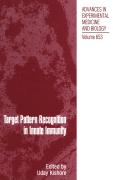
Target pattern recognition in innate immunity is responsible for the immediate, usually protective, responses shown against invading microorganisms, and itis the principal feature of self and non-self recognition by virtue of the recognition of structures on the microbial pathogens, which are not found on host cells. This is an area that has been very actively researched, over approximately the past 12 years, and therefore this volume provides a timely comprehensive, and up to date, summary of the types and range of cell surface, intracellular, and secreted, host proteins involved in the recognition of microbial products, and of the protective mechanisms triggered as a result of the recognition events. The Toll-like receptors, first described in Drosophila and now well-characterised on human cells, provide an excellent demonstration of the widerange of different microbial products recognised by this family of receptors and of the signalling pathways which are triggered thus leading to induction of inflammatory cytokines and the activation of genes producing antimicrobial products. In addition, several cell surface proteins involved in target patternrecognition have been described on the surfaces of macrophages (macrophage mannose receptor and macrophage scavenger receptors), and on dendritic cells (DEC205), and to be involved with the uptake and clearance of whole microorganisms and polyanioic ligands. Pattern recognition is also utilised by intracellular receptors, with NOD-like receptors in the cytosol recognizing microbial molecules and activating the production of inflammatory cytokines or pathways thatinduce the production of inflammatory molecules. Secreted proteins, such as the pentraxins, which includes the acute phase reacting, C-reactive protein (CRP) and serum amyloid protein (SAP), and the collectins (mannan binding lectin,lung surfactant protein A and D) and ficolins can also readily recruit killing and clearance systems. Indeed, the serum complement system, which is one of the major defence systems in the bloodstream, is efficiently activated by CR Pon its binding to the phosphocholine groups of microbial phospholipids—and the subsequent interaction of the bound CR P with C1q—to give classical pathway activation, or MBL, or ficolin, binding to arrays of mannose or N-acetyl-glucosamine residues, respectively, on the surfaces of microorganisms—to give lectin pathway activation. Also, in addition to the activation and clearance eventsassociated with complement activation by some of the secreted pattern recognition receptors, it is accepted that all these pattern recognition receptors can generally accelerate the uptake and clearance of microbes via phagocytic cells. In view of the growing interest in the cross-talk between innate and adaptive immunity, a thorough understanding of the initial recognition and triggering events, mediated via innate immune receptors, as addressed in this volume, is clearly very useful in helping to also fully understand the mechanisms of activation and control of the adaptive immune system—and to allow a full assessment of the relative roles played by innate immunity and adaptive immunity against a particular infection in higher organisms. INDICE: Macrophage Pattern Recognition Receptors in Immunity, Homeostasis and Self Tolerance.- Pattern Recognition by Toll-Like Receptors.- NOD-Like Receptors—Pivotal Guardians of the Immunological Integrity of Barier Organs.- Toll-Like Receptors and NOD-Like Receptors: Domain Architecture and Cellular Signalling.- Humoral Pattern Recognition Molecules: Mannan-Binding Lectin and Ficolins.- Lung Surfactant Proteins A and D as Pattern Recognition Proteins.- Pattern Recognition by Pentraxins.- Target Pattern Recognition by Complement Proteins of the Classical and Alternative Pathways.- Pattern Recognition in Phagocytic Clearance of Altered Self.- Structural Basis of Pattern Recognition by Innate Immune Molecules.- Lessons from the Fly: Pattern Recognition in Drosophilamelanogaster.- Immune Recognition of Plasmodium-Infected Erythrocytes.- Innate Immune Recognition in Tuberculosis Infection.
- ISBN: 978-1-4419-0900-8
- Editorial: Springer
- Encuadernacion: Cartoné
- Páginas: 222
- Fecha Publicación: 13/08/2009
- Nº Volúmenes: 1
- Idioma: Inglés
